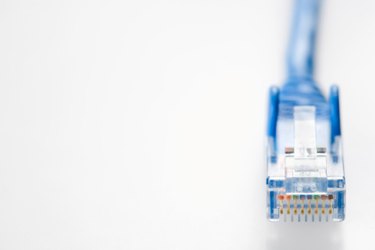
Registered jack (RJ) connectors are used in telecommunications systems. These jacks are similar in appearance to phone line jacks (RJ11). They vary in size and the number of wires they accommodate, as well as the data they transport. Two jack types commonly used in computing are RJ45 and RJ48. They each use eight wires in four twisted pairs.
Wires
Video of the Day
The RJ45 accommodates unshielded twisted pairs (UTP), while the RJ48 uses shielded twisted pairs (STP). Both types of wires have a PVC coating to protect data transfer from electrical interference. However, STP wires have an additional foil coating. STP wiring is needed for longer cables and for cables exposed to the elements, where the chances for data integrity to be compromised are increased.
Video of the Day
Connectors
RJ45 and RJ48 jacks look similar. In fact, an RJ45 jack can fit in an RJ48 port. The reverse is not always true because newer RJ48 jacks come with a notch that can only be accepted by an RJ48 port. Notched RJ48 jacks don't fit into RJ45 ports.
Uses
If you see the two together, you might recognize both as Ethernet connectors, because that is how the RJ45 jack is most commonly used. It was once used for some large phone systems, but no longer. Today it's used for computer connections. The RJ48 is commonly used with T1 lines and other applications that require longer cables that are possibly exposed to the environment. The RJ48 is better suited to this because of the added protection offered by the STP wiring.
Connector Pins
The pins on the connectors determine how your data is transmitted and what kinds of data is transmitted. For example the common phone line, RJ11, is for voice, fax and other analog data. RJ45 and RJ48 transmit digital data according to their pin connectors. RJ45 connectors have pins 1,2,3, and 6. RJ48 connectors use several pins groupings. Some include 1, 2, 4 and 5 or 1, 2, 7 and 8. Also, other wires may be used for additional data shielding.
Connecting Wires to Pins
What makes the difference in how the pins are used is where you post your pins. You can find color-coded pinouts online. Some jack casings have the color code etched on the sides of the casing. They can be connected straight in, crossed over or rolled. It's important to get this right so you have proper data transfer for the equipment you're using.